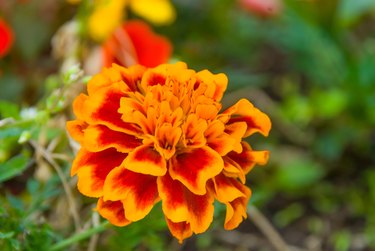
The marigold (Tagetes spp.) is a vibrant, annual flower that grows up to 4 feet tall in optimum growing environments and has showy blossoms of orange, yellow, red and cream colors. Marigolds go through different flower stages before actually blooming. Understanding these stages and the basics of marigold growing will ensure that you have many showy blooms in your garden.
A marigold requires moist — but not overly wet — soil to thrive and tends to not continuously flower if in shade. Native to Central and South America, marigolds grow in U.S. Department of Agriculture zones 2 to 11, depending on the species.
Video of the Day
Video of the Day
Varieties of Marigolds
Marigolds are classified by their characteristics, such as large, semi-dwarf and dwarf. African marigolds (Tagetes erecta) grow up to 14 inches tall and have blossoms up to 3 1/2 inches in diameter. French marigolds (Tagetes patula) come in large and dwarf varieties. This species ranges from 12 to 16 inches tall with blossoms up to 2 inches in diameter. Both of these species grow in USDA zones 2 to 11.
The Mexican marigold (Tagetes lucida, USDA zones 8-11) grows up to 2 1/2 feet tall. It is only a perennial in warmer climates but this species does well as an annual in cooler areas.
Triploids are a hybrid cross of the African and French species. Triploids' blossoms are about 2 inches in diameter, and the colors vary depending on the climates in which they are grown. Single marigolds look almost like a daisy and have a long stem.
Planting Marigolds From Seed
Sow marigolds in seed pots or flats where they will have good drainage. Cover seeds with 1/4 inch of vermiculite or perlite. Rather than wetting the soil directly, use a spray bottle to keep the soil moist. Keep the soil temperature around 70 to 75 degrees Fahrenheit.
Germination: Stages 1 and 2
If provided with the right climate, soil conditions and lighting, germination time for marigolds is five to eight days, which is part of stage 1. Promote germination in your seeds by covering the seed pots or flats to block out light. Test the soil pH to ensure that it is 6.0 to 6.2. Stage 2 occurs when the first root called the radicle emerges from the soil after germination.
Cotyledons: Stages 3 and 4
The cotyledons, or the embryonic leaves, appear at stage 3. Wait to begin fertilizing the marigold sprout with a mild water-soluble fertilizer when the first set of true leaves appears. At this stage, marigolds can start receiving full sunlight. Temperatures should remain between 65 and 75 degrees Fahrenheit to promote flowering and to allow the stem to continue to grow.
Flowering: Stage 5
Flowering occurs in marigolds 30 to 50 days after sowing seeds. At this time, you can transfer a marigold to a garden or pot. Keep the soil moist and remove spent flower heads to promote continuous flowering. Temperatures should remain 65 to 75 degrees Fahrenheit during the day and 65 to 70 degrees Fahrenheit at night.